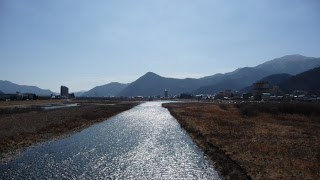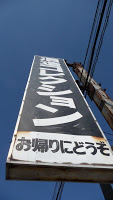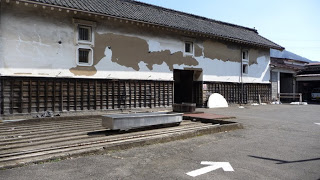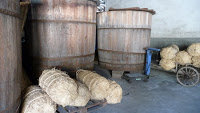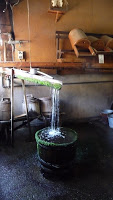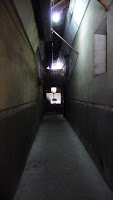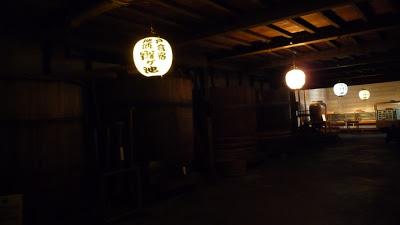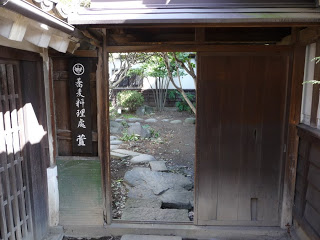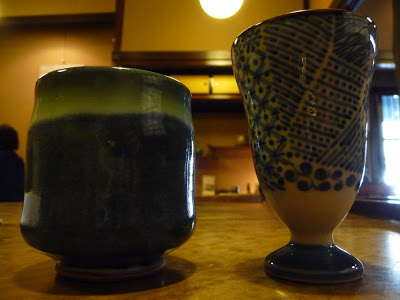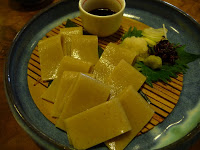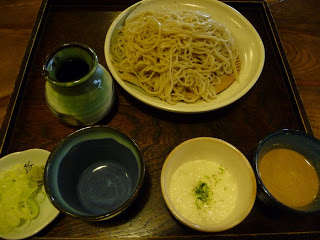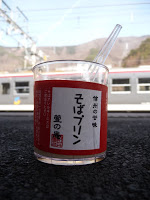It was nice walking back from Kamiyamada to Togura – just across the river, but it’s a big river and was a decent walk on a brilliantly clear day (if you’ve followed this whole series, I’d also like to mention that the hill at the end of the stretch of water in this picture is the Throwing-Away-Old-Women mountain mentioned previously). I actually wasn’t planning to go to Shuzo Collection since it seemed a bit far from the station, but on the day I was feeling good and didn’t mind walking more.
Reaching the station, I started north toward where I thought it was located and eventually came to this sign. Which told me that I should turn around and go back to the 2nd traffic light. Which is right in front of the station. Which means I’m a big dummy sometimes.
Back at that light, I was looking around for the museum, admiring a nice old warehouse that I had seen from the cab on the first night and taken pictures of when I walked by it 30 minutes previous. I asked an old guy where it was. After professing not to understand anything I said, he admitted that he did, indeed, speak Japanese. Then he professed to have no idea about any sake museum, and shuffled off as rapidly as possible. At which point I realized that the nice old warehouse was the place I had been looking for, and we had been standing in front of while I asked where it was and he professed not to know. Which means I’m a big dummy sometimes. All that bathing must have addled my brain.
Well, Shuzo Collection is a sake museum in an old brewery, and they have a nice soba restaurant attached (it’s called Kaya, but I don’t feel like posting separately). This makes is quite possibly Togura’s #1 attraction from my point of view, except for the onsen of course.
The museum is pretty self-guided, in the sense that there are absolutely no people in it (staff or patrons, while I was there). I assume the water pouring out of this mossy spout was what they used/use to make the sake, and the dipper was there to let you drink it? Anyway, that’s certainly what I used it for.
Nice to wander around – must be cool in summer, because it was a bit warmer in winter. Actually this weekend seemed like the last throes of winter. It’s already warm and spring-y in Tokyo.
There’s a fine line between clever and stupid, and without post-processing, I’m afraid this clever shot is over the line.
Of course, there are only so many times you can tour a sake brewery, and I’ve had my fill of them over many years of Japan trips and living. I got through at speed and went off to lunch. How could you say no to a face like this? Many soba restaurants, not including this one, use the word ‘an’ in their names, meaning something like ‘hermitage’, and I think meant to connote a certain purity and austerity in their approach to the noodle. Not many places have entrances worthy of a hermitage, but this sort of does.
My understanding of their brewing and sales was a bit limited, but they did have half a dozen sakes for sale in the gift shop. And soba has become something that I prefer to drink a glass of sake with. They have two main labels for sale there, Nishinomon (西乃門) and Unzan (雲山), and I much preferred the Nishinomon brews (aside: I hate how crappy food writers use the word ‘brew’ to refer to sake. Not sure why it’s so objectionable to my delicate sensibilities. It just smacks of facile thesaurus use.) and ordered up a quite-reasonably-priced glass of their daiginjo to go with lunch. After the last two nights, one glass was more than enough. By the way, the blue pottery on the left, again invisible without post-processing, is the local specialty; the glaze is made from powdered swallow intestines or something equally exotic. I embiggened the picture so you could better gaze at the vessels crafted to hold the brews.
Their menu said this ‘soba sashimi’ was their original invention, so I had to try it (and I had seen it on two other menus earlier in the weekend, so I was interested). It did what it said on the tin, which was to provide one with a thick, chewy, soba experience and a vehicle for wasabi and sauce. Just think of it as a thick lasagna noodle, not quite cooked (a fresh noodle though, so there’s no dry bit in the middle). A nice idea; I’m not sure if the world is ready for something like pasta sashimi though.
Here’s the main event, the 3-color soba set. Good noodles, thin and strong, but the sauces were the interesting part. The white one is grated potato, the a gluey and slimey substance that I more or less hate. For this, the procedure I followed was to dip the noodles, get ’em gooey, then dip again in regular tsuyu (I think this was wrong, and you’re supposed to mix the tororo with the tsuyu, but I didn’t want to ruin my tsuyu). Surprisingly not disgusting. On the right though, the third sauce was excellent – sort of a thick walnut milk. Never occured to me to have nuts with soba before, but this seemed so natural and delicious that it can’t be uncommon. Walnuts are another local specialty.
They had soba pudding on the menu, yet another original invention of the store (errrrr…). I held off on getting that while in the restaurant, but while buying my take-home sake (they had 330ml bottles of daiginjo, a rarity, and it was the one I liked and drank with lunch) I got one to occupy 30 seconds of the potentially interminable wait for the train. As it was, I only had to wait 20 minutes out of the hour between trains at mid-day, which was a blessing. You may be shocked by this photography – I know how edgy it is that I put the pudding on the ground to take this – but I was not shocked by the taste. It tasted like soba, and the texture was like pudding. Again, does what it says on the tin, if you’ll grant me leave to use expressions that give the mistaken impression that I’m English.
What ho! and all that rot. Topping noodles, old boy!
02-6275-0033
